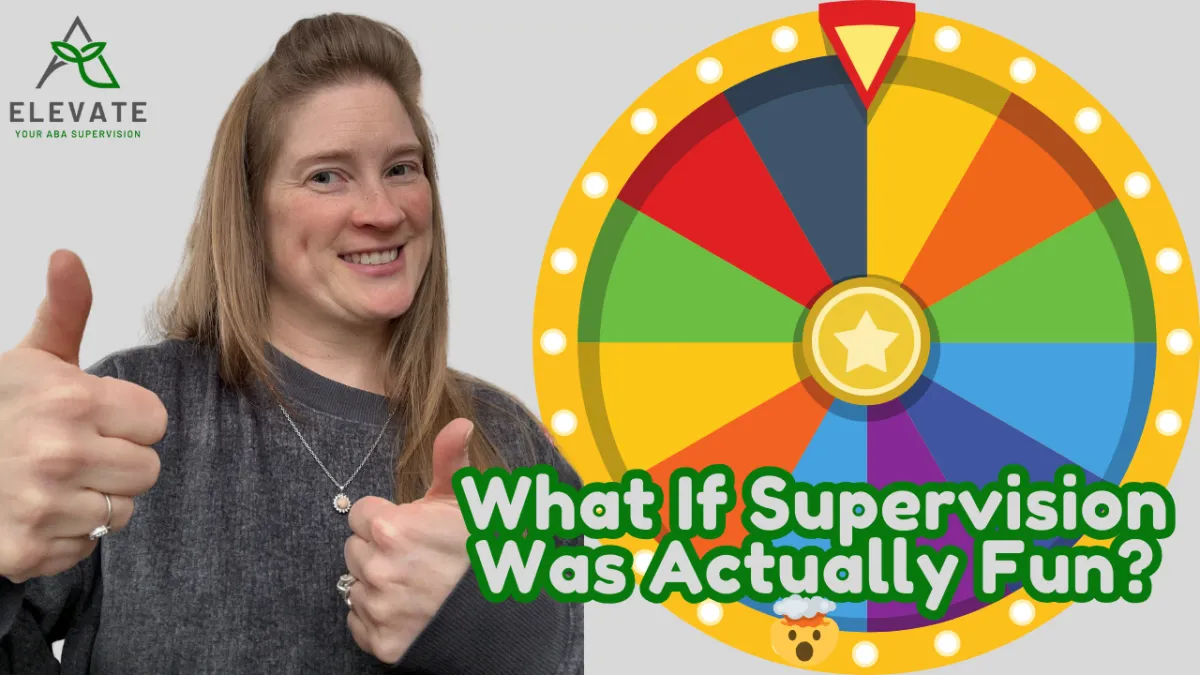
How to Make Supervision for RBTs® Less Awkward, More Awesome (and Actually Helpful)
🤔 Real Talk: Does Your Supervision Feel Like a Forced Icebreaker?
Let’s be honest. You show up to supervise your RBT® and feel like the overprepared camp counselor who’s trying to get teens to sing Kumbaya. You're pulling out all the “right” activities—task list reviews, BST, a sprinkle of feedback—but it still feels…off.
Your RBT® smiles and nods. You do the thing. You log the time.
But deep down, you’re wondering:
“Are they actually learning… or just tolerating me?”
And don’t get me started on remote supervision. Or group supervision. Or the kind where you’ve got a brand-new RBT® who thinks DRO is the latest Marvel character.
You’re doing the best you can. But you didn’t become a BCBA® to babysit staff checklists and hope for the best.
You’re here to build confident, compassionate, clinically sharp humans.
So let’s talk about how to supervise like that.
How to Make Supervision for RBTs® Less Awkward, More Awesome (and Actually Helpful)
How to Make Supervision for RBTs® Less Awkward, More Awesome (and Actually Helpful)
Real Talk: Does Your Supervision Feel Like a Forced Icebreaker?
What Supervision Should Feel Like (According to Science and Sanity)
Supervision Activities That Don’t Suck (And Actually Work)
Match the Activity to Your Format
Pro Tips for Maximum Engagement
Adjusting for Real Life: Because Supervision Isn’t a One-Size Snuggie
Remote Supervision = Coaching in Pajamas
Group vs Individual Supervision = Jazz Band vs Solo Practice
New vs Seasoned RBTs® = “Please Tell Me What DRO Means” vs “Let’s Redesign This Protocol”
Want Supervision to Be This Fun and Focused Every Week?
Before You Go: Ask Yourself This
🧠 What Supervision Should Feel Like (According to Science and Sanity)
Good supervision changes behavior. (Not just of the client—but of the RBT®.)
And the research has receipts.
In their iconic supervision trilogy, Parsons, Rollyson, and Reid basically say this:
If your supervision isn’t using modeling, guided practice, and performance feedback…
You might just be talking to yourself.
(Okay, that’s not a direct quote, but it’s the gist.)
That’s why the gold standard for staff training is Behavior Skills Training (BST):
Instruction (Tell)
Modeling (Show)
Rehearsal (Do)
Feedback (Fix it—nicely)

That’s also why your supervision activities shouldn’t just look good on paper—they should be sticky, flexible, and actually enjoyable.
Like good gum. Or your favorite pair of leggings.
🧰 Supervision Activities That Don’t Suck (And Actually Work)
Here’s your new Supervision Survival Kit, filled with activities that:
Actually teach skills
Build trust
Don’t make your RBT® feel like they're back in high school chemistry class
The Supervision Game Show

🧩 Match the Activity to Your Format



🌱 New RBT®? Start Here:
Prompt Olympics
Explain It to a Toddler
Video Review & Roast (w/ lots of grace!)
💼 Experienced RBT®? Try:
Shark Tank
Backward Interview
Error Detective
🔁 Pro Tips for Maximum Engagement:
Set a supervision theme for each month (e.g., “Prompting Power,” “Reinforcement Remix”)
Let RBTs® pick the game next week if they win this round
Combine with data tracking
🧠 Adjusting for Real Life: Because Supervision Isn’t a One-Size Snuggie
Let’s talk real-world variables—because supervision with a new RBT® on Zoom is not the same as group supervision in a sensory-gym circus.
Here’s how to adapt without losing the magic:
📍 Remote Supervision = Coaching in Pajamas
Pros: Flexibility, convenience, fewer logistical meltdowns
Cons: Tech fails, awkward silences, can't high-five through a screen
🧠 Use:
Screen sharing with video playback for pause-and-comment sessions
Digital whiteboards or shared docs for collaborative problem-solving
Role-play over Zoom: yes, it’s awkward—but so is an extinction burst in Target
💡 Pro tip: Record short skill videos in your own environment and share them for reference. Your couch can be your new clinic.
🧑🤝🧑 Group vs Individual Supervision = Jazz Band vs Solo Practice

💡 Do both, and plan intentionally. Don’t let group time become “scroll and nod” time. Everyone participates or no one gets snacks.
🌱 New vs Seasoned RBTs® = “Please Tell Me What DRO Means” vs “Let’s Redesign This Protocol”

🧠 Bonus idea: Pair them together for peer mentoring. New RBT® learns, seasoned one gets leadership practice.
🎁 Want Supervision to Be This Fun and Focused Every Week?
You don’t have to make it all from scratch.
Check out CEUs that don’t make you yawn:
The Supervisor's Toolbox: Strategies for Building Effective Relationships
The Retention Revolution: The Secret to Reducing RBT Burnout
The Feedback Loop: Engineering a Culture of Collaboration and Growth in ABA
Precision Supervision: High-Yield Tools for Thriving RBTs® and Balanced BCBAs®
📍 All at Elevate Your ABA Supervision —because you can be ethical and entertaining.
💬 Before You Go: Ask Yourself This
“What skill does this RBT® need to be a little more awesome next week?”
Then reverse-engineer your supervision plan from that.
Supervision isn’t just compliance. It’s a clinical intervention. A culture-builder. A behavior shaper.
It’s your secret sauce—the thing that makes your practice tick, your clients thrive, and your team stay.
So let's make it awesome. Let’s make it human. Let’s make it you.
🎤 Final Message:
Supervision can be clinical and creative.
So grab your metaphorical buzzer, spin the wheel, and supervise like you mean it.
P.S. Your RBTs® will thank you. Eventually. Probably with stickers.
#RBTsupervision #FunABA #BCBAsupervisiontips #BehaviorSkillsTraining #ClinicalABA #SupervisionDoneRight #CreativeSupervision #EngagedRBTs #ElevateYourABA
#ABAmentorship
